Citizen Science Mosquito Surveillance by Ad Hoc Observation Using the iNaturalist Platform
Abstract
:1. Introduction
2. Materials and Methods
2.1. Definition of Citizen Science
2.2. Establishing the Project on iNaturalist
2.3. Quantitative Methods in Mosquito Community Composition
2.4. iNaturalist User Perceptions
3. Results
3.1. Quantitative Mosquito Observation Data
3.2. iNaturalist User Perceptions
4. Discussion
5. Conclusions
Author Contributions
Funding
Institutional Review Board Statement
Informed Consent Statement
Data Availability Statement
Acknowledgments
Conflicts of Interest
References
- Amos, H.M.; Starke, M.J.; Rogerson, T.M.; Colón Robles, M.; Andersen, T.; Boger, R.; Campbell, B.A.; Low, R.D.; Nelson, P.; Overoye, D. GLOBE Observer data: 2016–2019. Earth Space Sci. 2020, 7, e2020EA001175. [Google Scholar] [CrossRef] [PubMed]
- Bartumeus, F.; Oltra, A.; Palmer, J.R.B. Citizen Science: A Gateway for Innovation in Disease-Carrying Mosquito Management? Trends Parasitol. 2018, 34, 727–729. [Google Scholar] [CrossRef] [PubMed]
- Cox, J.; Oh, E.Y.; Simmons, B.; Lintott, C.; Masters, K.; Greenhill, A.; Graham, G.; Holmes, K. Defining and measuring success in online citizen science: A case study of Zooniverse projects. Comput. Sci. Eng. 2015, 17, 28–41. [Google Scholar] [CrossRef]
- Nugent, J. iNaturalist. Sci. Scope 2018, 41, 12–13. [Google Scholar] [CrossRef]
- Simpson, R.; Page, K.R.; De Roure, D. Zooniverse: Observing the World’s Largest Citizen Science Platform. In Proceedings of the 23rd International Conference on World Wide Web, Seoul, Korea, 7–11 April 2014; Association for Computing Machinery: New York, NY, USA, 2014; pp. 1049–1054. [Google Scholar]
- Sullivan, B.L.; Wood, C.L.; Iliff, M.J.; Bonney, R.E.; Fink, D.; Kelling, S. eBird: A citizen-based bird observation network in the biological sciences. Biol. Conserv. 2009, 142, 2282–2292. [Google Scholar] [CrossRef]
- Aristeidou, M.; Herodotou, C.; Ballard, H.L.; Young, A.N.; Miller, A.E.; Higgins, L.; Johnson, R.F. Exploring the participation of young citizen scientists in scientific research: The case of iNaturalist. PLoS ONE 2021, 16, e0245682. [Google Scholar] [CrossRef]
- iNaturalist. What Is iNaturalist? Available online: https://www.inaturalist.org/pages/help#general1 (accessed on 10 January 2022).
- Chandler, M.; See, L.; Copas, K.; Bonde, A.M.; López, B.C.; Danielsen, F.; Legind, J.K.; Masinde, S.; Miller-Rushing, A.J.; Newman, G. Contribution of citizen science towards international biodiversity monitoring. Biol. Conserv. 2017, 213, 280–294. [Google Scholar] [CrossRef] [Green Version]
- McKinley, D.C.; Miller-Rushing, A.J.; Ballard, H.L.; Bonney, R.; Brown, H.; Cook-Patton, S.C.; Evans, D.M.; French, R.A.; Parrish, J.K.; Phillips, T.B. Citizen science can improve conservation science, natural resource management, and environmental protection. Biol. Conserv. 2017, 208, 15–28. [Google Scholar] [CrossRef] [Green Version]
- Unger, S.; Rollins, M.; Tietz, A.; Dumais, H. iNaturalist as an engaging tool for identifying organisms in outdoor activities. J. Biol. Educ. 2020, 55, 537–547. [Google Scholar] [CrossRef]
- Gazdic, M.; Groom, Q. iNaturalist is an Unexploited Source of Plant-Insect Interaction Data. Biodivers. Inf. Sci. Stand. 2019. Available online: https://link.gale.com/apps/doc/A646476433/AONE?u=unisa&sid=googleScholar&xid=254f77a6 (accessed on 20 March 2022).
- Mesaglio, T.; Callaghan, C.T. An overview of the history, current contributions and future outlook of iNaturalist in Australia. Wildl. Res. 2021, 48, 289. [Google Scholar] [CrossRef]
- Menz, M.H.; Brown, B.V.; Wotton, K.R. Quantification of migrant hoverfly movements (Diptera: Syrphidae) on the West Coast of North America. R. Soc. Open Sci. 2019, 6, 190153. [Google Scholar] [CrossRef] [Green Version]
- Mesaglio, T.; Soh, A.; Kurniawidjaja, S.; Sexton, C. ‘First Known Photographs of Living Specimens’: The power of iNaturalist for recording rare tropical butterflies. J. Insect Conserv. 2021, 25, 905–911. [Google Scholar] [CrossRef]
- Kirchhoff, C.; Callaghan, C.T.; Keith, D.A.; Indiarto, D.; Taseski, G.; Ooi, M.K.J.; Le Breton, T.D.; Mesaglio, T.; Kingsford, R.T.; Cornwell, W.K. Rapidly mapping fire effects on biodiversity at a large-scale using citizen science. Sci. Total Environ. 2021, 755, 142348. [Google Scholar] [CrossRef]
- Echeverria, A.; Ariz, I.; Moreno, J.; Peralta, J.; Gonzalez, E.M. Learning Plant Biodiversity in Nature: The Use of the Citizen–Science Platform iNaturalist as a Collaborative Tool in Secondary Education. Sustainability 2021, 13, 735. [Google Scholar] [CrossRef]
- Van Horn, G.; Mac Aodha, O.; Song, Y.; Cui, Y.; Sun, C.; Shepard, A.; Adam, H.; Perona, P.; Belongie, S. The Inaturalist Species Classification and Detection Dataset. In Proceedings of the IEEE Conference on Computer Vision and Pattern Recognition, Salt Lake City, UT, USA, 18–23 June 2018; IEEE: New York, NY, USA, 2018; pp. 8769–8778. [Google Scholar]
- Cull, B. Potential for online crowdsourced biological recording data to complement surveillance for arthropod vectors. PLoS ONE 2021, 16, e0250382. [Google Scholar] [CrossRef]
- Cohnstaedt, L.W.; Ladner, J.; Campbell, L.R.; Busch, N.; Barrera, R. Determining Mosquito Distribution from Egg Data: The Role of the Citizen Scientist. Am. Biol. Teach. 2016, 78, 317–322. [Google Scholar] [CrossRef]
- Cohnstaedt, L.W.; Snyder, D.; Maki, E.; Schafer, S. Crowdsourcing methodology: Establishing the Cervid Disease Network and the North American Mosquito Project. Vet. Ital. 2016, 52, 195–200. [Google Scholar]
- Sousa, L.B.; Craig, A.; Chitkara, U.; Fricker, S.; Webb, C.; Williams, C.; Baldock, K. Methodological Diversity in Citizen Science Mosquito Surveillance: A Scoping Review. Citiz. Sci. Theory Pract. 2022, 7, 8. [Google Scholar] [CrossRef]
- Palmer, J.R.B.; Oltra, A.; Collantes, F.; Delgado, J.A.; Lucientes, J.; Delacour, S.; Bengoa, M.; Eritja, R.; Bartumeus, F. Citizen science provides a reliable and scalable tool to track disease-carrying mosquitoes. Nat. Commun. 2017, 8, 916. [Google Scholar] [CrossRef] [Green Version]
- Braz Sousa, L.; Fricker, S.R.; Doherty, S.S.; Webb, C.E.; Baldock, K.L.; Williams, C.R. Citizen science and smartphone e-entomology enables low-cost upscaling of mosquito surveillance. Sci. Total Environ. 2020, 704, 135349. [Google Scholar] [CrossRef]
- Carrillo, M.A.; Kroeger, A.; Cardenas Sanchez, R.; Diaz Monsalve, S.; Runge-Ranzinger, S. The use of mobile phones for the prevention and control of arboviral diseases: A scoping review. BMC Public Health 2021, 21, 110. [Google Scholar] [CrossRef] [PubMed]
- Eritja, R.; Ruiz-Arrondo, I.; Delacour-Estrella, S.; Schaffner, F.; Álvarez-Chachero, J.; Bengoa, M.; Puig, M.-Á.; Melero-Alcíbar, R.; Oltra, A.; Bartumeus, F. First detection of Aedes japonicus in Spain: An unexpected finding triggered by citizen science. Parasites Vectors 2019, 12, 53. [Google Scholar] [CrossRef] [PubMed]
- Braz Sousa, L.; Fricker, S.; Williams, C. How a Citizen Science Program is Innovating Mosquito Surveillance in Australia. In Mosquito Bites in the Asia Pacific Region; Mosquito Control Association of Australia Inc.: Gold Coast, QLD, Australia, 2020; pp. 68–71. [Google Scholar]
- Bonney, R.; Cooper, C.B.; Dickinson, J.; Kelling, S.; Phillips, T.; Rosenberg, K.V.; Shirk, J. Citizen Science: A Developing Tool for Expanding Science Knowledge and Scientific Literacy. BioScience 2009, 59, 977–984. [Google Scholar] [CrossRef]
- Miller-Rushing, A.; Primack, R.; Bonney, R. The history of public participation in ecological research. Front. Ecol. Environ. 2012, 10, 285–290. [Google Scholar] [CrossRef]
- Phillips, T.; Porticella, N.; Constas, M.; Bonney, R. A Framework for Articulating and Measuring Individual Learning Outcomes from Participation in Citizen Science. Citiz. Sci. Theory Pract. 2018, 3, 3. [Google Scholar] [CrossRef] [Green Version]
- Cooper, C.B.; Hawn, C.L.; Larson, L.R.; Parrish, J.K.; Bowser, G.; Cavalier, D.; Dunn, R.R.; Haklay, M.; Gupta, K.K.; Jelks, N.T.O.; et al. Inclusion in citizen science: The conundrum of rebranding. Science 2021, 372, 1386–1388. [Google Scholar] [CrossRef]
- Liebenberg, L.; Lombard, M.; Shermer, M.; Xhukwe, U.; Biesele, M.; Carruthers, P.; Kxao, O.; Hansson, S.O.; Langwane, H.K.; Elbroch, L.M. Tracking Science: An Alternative for Those Excluded by Citizen Science. Citiz. Sci. Theory Pract. 2021, 6, 1–16. [Google Scholar] [CrossRef]
- Wittmann, J.; Girman, D.; Crocker, D. Using iNaturalist in a coverboard protocol to measure data quality: Suggestions for project design. Citiz. Sci. Theory Pract. 2019, 4, 21. [Google Scholar] [CrossRef] [Green Version]
- Hochmair, H.H.; Scheffrahn, R.H.; Basille, M.; Boone, M. Evaluating the data quality of iNaturalist termite records. PLoS ONE 2020, 15, e0226534. [Google Scholar] [CrossRef]
- Van den Hurk, A.F.; Nicholson, J.; Beebe, N.W.; Davis, J.; Muzari, O.M.; Russell, R.C.; Devine, G.J.; Ritchie, S.A. Ten years of the Tiger: Aedes albopictus presence in Australia since its discovery in the Torres Strait in 2005. One Health 2016, 2, 19–24. [Google Scholar] [CrossRef] [Green Version]
- Oksanen, J. Multivariate Analysis of Ecological Communities in R: Vegan Tutorial; University of Oulu: Oulu, Finland, 2007. [Google Scholar]
- Russell, R.C. Mosquito-borne disease and climate change in Australia: Time for a reality check. Aust. J. Entomol. 2009, 48, 1–7. [Google Scholar] [CrossRef]
- Webb, C.; Doggett, S.; Russell, R. A Guide to Mosquitoes of Australia; CSIRO Publishing: Clayton, VIC, Australia, 2016. [Google Scholar]
- Callaghan, C.T.; Poore, A.G.; Hofmann, M.; Roberts, C.J.; Pereira, H.M. Large-bodied birds are over-represented in unstructured citizen science data. Sci. Rep. 2021, 11, 19073. [Google Scholar] [CrossRef]
- Jansen, C.C.; Shivas, M.A.; May, F.J.; Pyke, A.T.; Onn, M.B.; Lodo, K.; Hall-Mendelin, S.; McMahon, J.L.; Montgomery, B.L.; Darbro, J.M.; et al. Epidemiologic, Entomologic, and Virologic Factors of the 2014-15 Ross River Virus Outbreak, Queensland, Australia. Emerg. Infect. Dis. 2019, 25, 2243–2252. [Google Scholar] [CrossRef] [Green Version]
- Ryan, P.A.; Do, K.-A.; Kay, B.H. Spatial and Temporal Analysis of Ross River Virus Disease Patterns at Maroochy Shire, Australia: Association Between Human Morbidity and Mosquito (Diptera: Culicidae) Abundance. J. Med. Entomol. 1999, 36, 515–521. [Google Scholar] [CrossRef]
- Williams, G. Aspects of the reproductive ecology of a south-east Australian Avicennia marina mangrove community—Flower visitors and potential pollinators. Cunninghamia 2020, 20, 209–244. [Google Scholar]
- Meyer Steiger, D.B.; Ritchie, S.A.; Laurance, S.G.W. Mosquito communities and disease risk influenced by land use change and seasonality in the Australian tropics. Parasites Vectors 2016, 9, 387. [Google Scholar] [CrossRef] [Green Version]
- Webb, C.E.; Russell, R.C. Towards management of mosquitoes at Homebush Bay, Sydney, Australia. I. Seasonal activity and relative abundance of adults of Aedes vigilax, Culex sitiens, and other salt-marsh species, 1993–1994 through 1997-98. J. Am. Mosq. Control Assoc. 1999, 15, 242–249. [Google Scholar]
- Williams, C.R.; Williams, S.R.; Nicholson, J.; Little, S.M.; Riordan, J.; Fricker, S.R.; Kokkinn, M.J. Diversity and seasonal succession of coastal mosquitoes (Diptera: Culicidae) in the northern Adelaide region of South Australia. Aust. J. Entomol. 2009, 48, 107–112. [Google Scholar] [CrossRef]
- Hanford, J.K.; Webb, C.E.; Hochuli, D.F. Habitat Traits Associated with Mosquito Risk and Aquatic Diversity in Urban Wetlands. Wetlands 2019, 39, 743–758. [Google Scholar] [CrossRef]
- Braz Sousa, L.; Fricker, S.R.; Webb, C.E.; Williams, C.R. Mozzie Month Technical Report; University of South Australia: Adelaide, SA, Australia, 2021. [Google Scholar]
- Di Cecco, G.J.; Barve, V.; Belitz, M.W.; Stucky, B.J.; Guralnick, R.P.; Hurlbert, A.H. Observing the Observers: How Participants Contribute Data to iNaturalist and Implications for Biodiversity Science. BioScience 2021, 71, 1179–1188. [Google Scholar] [CrossRef]
- Brossard, D.; Lewenstein, B.; Bonney, R. Scientific knowledge and attitude change: The impact of a citizen science project. Int. J. Sci. Educ. 2005, 27, 1099–1121. [Google Scholar] [CrossRef]
- Price, C.A.; Lee, H.-S. Changes in participants’ scientific attitudes and epistemological beliefs during an astronomical citizen science project. J. Res. Sci. Teach. 2013, 50, 773–801. [Google Scholar] [CrossRef]
- Wright, D.R.; Underhill, L.G.; Keene, M.; Knight, A.T. Understanding the Motivations and Satisfactions of Volunteers to Improve the Effectiveness of Citizen Science Programs. Soc. Nat. Resour. 2015, 28, 1013–1029. [Google Scholar] [CrossRef]
- Crall, A.W.; Jordan, R.; Holfelder, K.; Newman, G.J.; Graham, J.; Waller, D.M. The impacts of an invasive species citizen science training program on participant attitudes, behavior, and science literacy. Public Underst. Sci. 2012, 22, 745–764. [Google Scholar] [CrossRef] [Green Version]
- Domroese, M.C.; Johnson, E.A. Why watch bees? Motivations of citizen science volunteers in the Great Pollinator Project. Biol. Conserv. 2017, 208, 40–47. [Google Scholar] [CrossRef]
- Cooper, C.B.; Smith, J.A. Gender Patterns in Bird-related Recreation in the USA and UK. Ecol. Soc. 2010, 15, 4. [Google Scholar] [CrossRef] [Green Version]
- Kampen, H.; Medlock, J.M.; Vaux, A.G.C.; Koenraadt, C.J.M.; van Vliet, A.J.H.; Bartumeus, F.; Oltra, A.; Sousa, C.A.; Chouin, S.; Werner, D. Approaches to passive mosquito surveillance in the EU. Parasites Vectors 2015, 8, 9. [Google Scholar] [CrossRef] [Green Version]
- Lwin, M.O.; Jayasundar, K.; Sheldenkar, A.; Wijayamuni, R.; Wimalaratne, P.; Ernst, K.C.; Foo, S. Lessons From the Implementation of Mo-Buzz, a Mobile Pandemic Surveillance System for Dengue. JMIR Public Health Surveill 2017, 3, e65. [Google Scholar] [CrossRef]
- Craig, A.T.; Kama, N.; Fafale, G.; Bugoro, H. Citizen science as a tool for arboviral vector surveillance in a resourced-constrained setting: Results of a pilot study in Honiara, Solomon Islands, 2019. BMC Public Health 2021, 21, 509. [Google Scholar] [CrossRef]
- Ledogar, R.J.; Hernández-Alvarez, C.; Morrison, A.C.; Arosteguí, J.; Morales-Perez, A.; Nava-Aguilera, E.; Legorreta-Soberanis, J.; Caldwell, D.; Coloma, J.; Harris, E.; et al. When communities are really in control: Ethical issues surrounding community mobilisation for dengue prevention in Mexico and Nicaragua. BMC Public Health 2017, 17, 410. [Google Scholar] [CrossRef] [Green Version]
- Webb, C.; Clancy, J.; Doggett, S.L.; McAlister, E.; Williams, C.; Fricker, S.; van den Hurk, A.; Lessard, B.; Lenagan, J.; Walter, M. First record of the mosquito Aedes (Downsiomyia) shehzadae (Diptera: Culicidae) in Australia: A unique discovery aided by citizen science. J. Vector Ecol. 2022, 47, 133–137. [Google Scholar] [CrossRef]
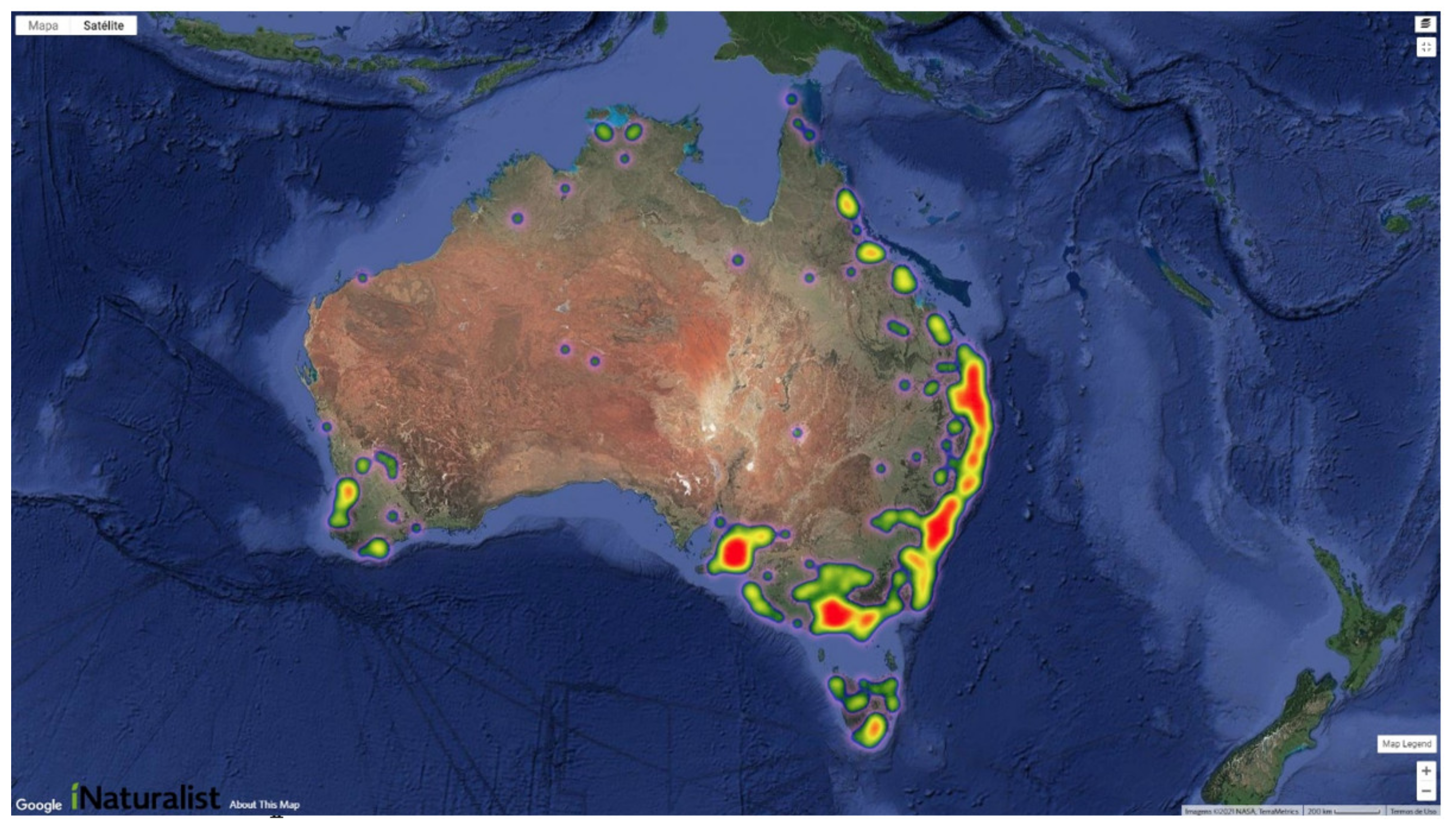
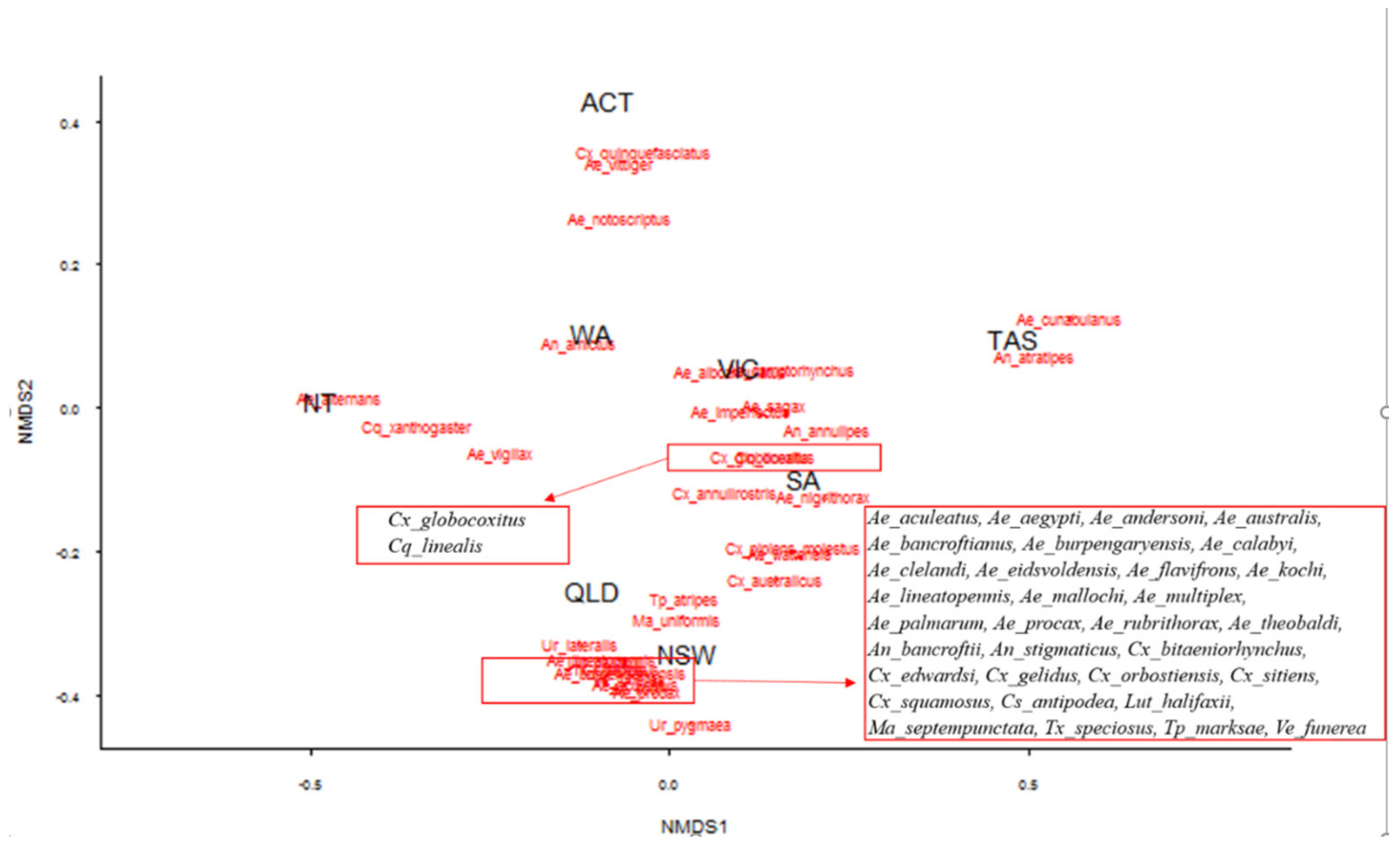
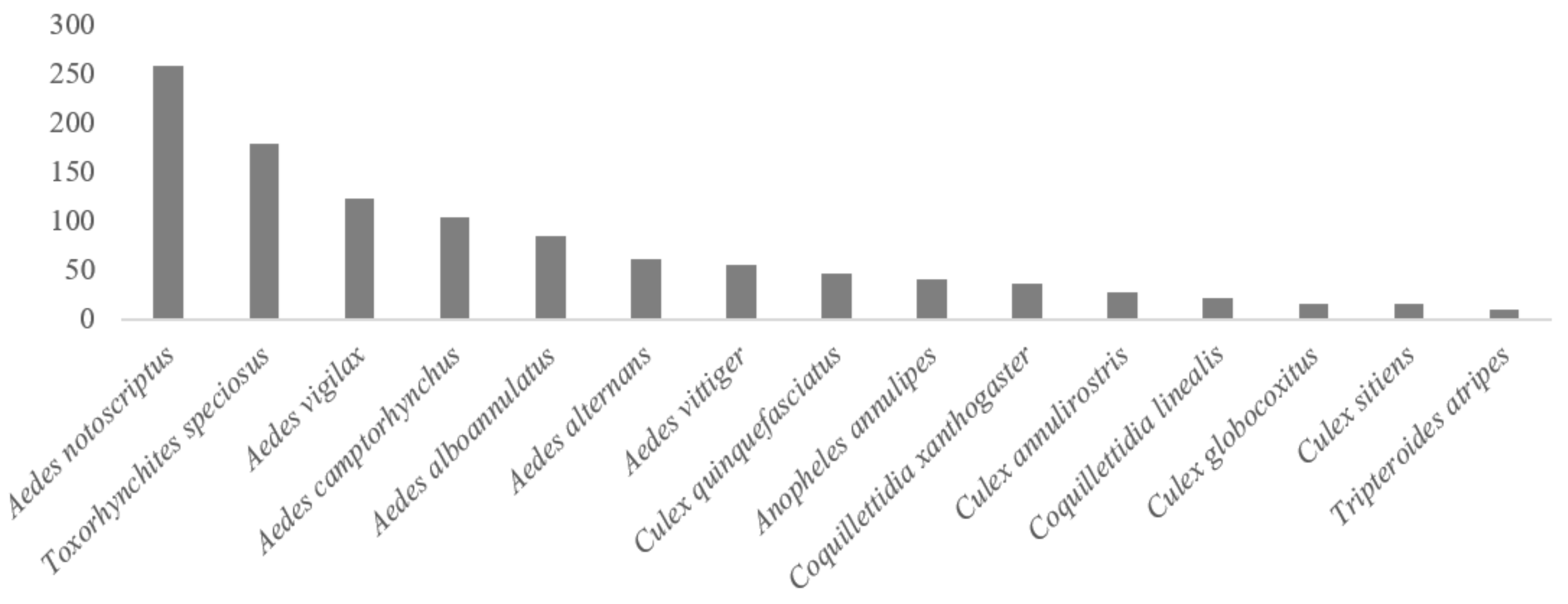
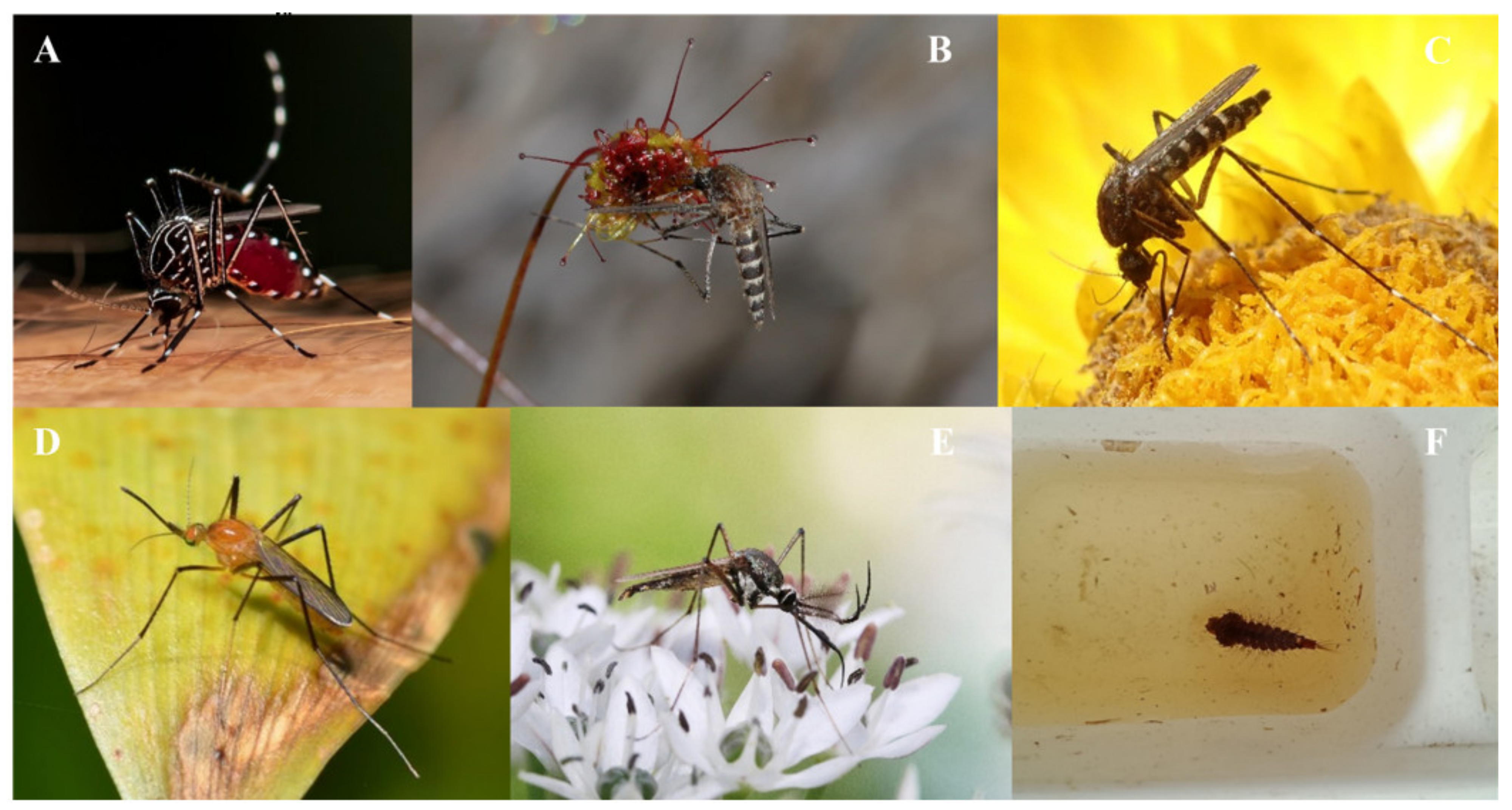
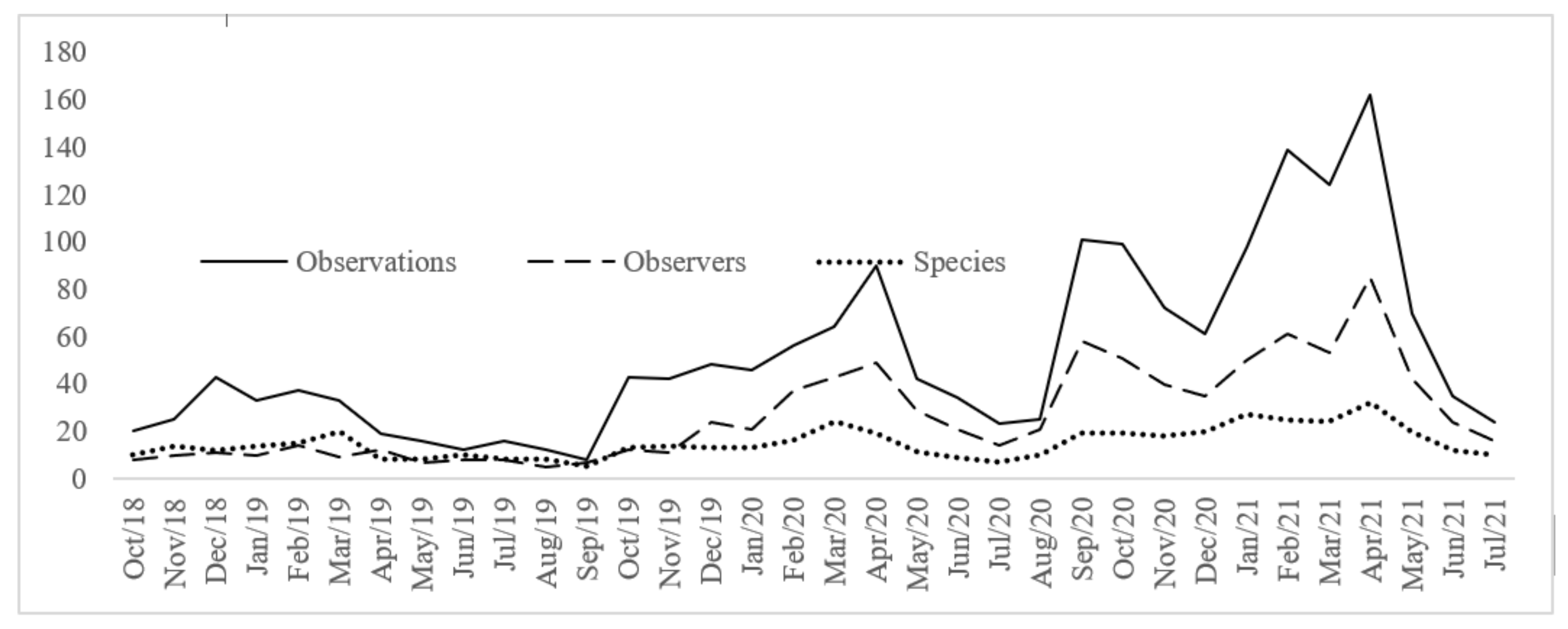
| Quality Grade | Any (Research Grade, Needs ID, Casual) |
|---|---|
| Identifications | Any (most agree, some agree, most disagree); Captive/cultivated: any (yes, no) |
| Project | mozzie-monitors-australia (project settings already include all mosquitoes [Family Culicidae], observed from any state in Australia, uploaded by any users, any quality grade, any media type, and from any date) |
| Date range | Any |
| Columns | default selection, containing all data for Basic (ID, user ID, URL, license, time, etc), Geo (all available coordinates) and Taxon. |
| Species | Observations | |
|---|---|---|
| Australian Capital Territory (ACT) * | 3 (5%) | 7 (1%) |
| New South Wales (NSW) | 42 (72%) | 341 (29%) |
| Northern Territory (NT) | 4 (7%) | 34 (3%) |
| Queensland (QLD) | 26 (45%) | 308 (26%) |
| South Australia (SA) | 22 (38%) | 345 (29%) |
| Tasmania (TAS) | 7 (12%) | 11 (1%) |
| Victoria (VIC) | 12 (21%) | 125 (11%) |
| Western Australia (WA) | 7 (12%) | 16 (1%) |
| Australia | 57 (100%) | 1187 (100%) |
| ACT | NSW | NT | QLD | SA | TAS | VIC | WA | Australia | ||
|---|---|---|---|---|---|---|---|---|---|---|
| 1 | Aedes aculeatus | 0 | 3 | 0 | 1 | 0 | 0 | 0 | 0 | 4 |
| 2 | Aedes aegypti | 0 | 0 | 0 | 5 | 0 | 0 | 0 | 0 | 5 |
| 3 | Aedes alboannulatus | 0 | 15 | 0 | 1 | 18 | 1 | 46 | 3 | 84 |
| 4 | Aedes alternans | 0 | 29 | 29 | 0 | 0 | 0 | 2 | 1 | 61 |
| 5 | Aedes andersoni | 0 | 0 | 0 | 0 | 0 | 1 | 0 | 0 | 1 |
| 6 | Aedes australis | 0 | 0 | 0 | 0 | 1 | 0 | 0 | 0 | 1 |
| 7 | Aedes bancroftianus | 0 | 0 | 0 | 0 | 2 | 0 | 0 | 0 | 2 |
| 8 | Aedes burpengaryensis | 0 | 1 | 0 | 1 | 0 | 0 | 0 | 0 | 2 |
| 9 | Aedes calabyi | 0 | 0 | 0 | 0 | 1 | 0 | 0 | 0 | 1 |
| 10 | Aedes camptorhynchus | 0 | 2 | 0 | 0 | 82 | 4 | 14 | 2 | 104 |
| 11 | Aedes clelandi | 0 | 0 | 0 | 0 | 2 | 0 | 0 | 0 | 2 |
| 12 | Aedes cunabulanus | 0 | 0 | 0 | 0 | 0 | 2 | 0 | 0 | 2 |
| 13 | Aedes eidsvoldensis | 0 | 1 | 0 | 0 | 0 | 0 | 0 | 0 | 1 |
| 14 | Aedes flavifrons | 0 | 4 | 0 | 0 | 0 | 0 | 0 | 0 | 4 |
| 15 | Aedes imperfectus | 0 | 1 | 0 | 0 | 0 | 0 | 1 | 0 | 2 |
| 16 | Aedes kochi | 0 | 4 | 0 | 1 | 0 | 0 | 0 | 0 | 5 |
| 17 | Aedes lineatopennis | 0 | 1 | 0 | 6 | 0 | 0 | 0 | 0 | 7 |
| 18 | Aedes mallochi | 0 | 1 | 0 | 0 | 0 | 0 | 0 | 0 | 1 |
| 19 | Aedes multiplex | 0 | 5 | 0 | 0 | 0 | 0 | 0 | 0 | 5 |
| 20 | Aedes nigrithorax | 0 | 0 | 0 | 0 | 1 | 0 | 0 | 0 | 1 |
| 21 | Aedes notoscriptus | 5 | 79 | 1 | 48 | 76 | 1 | 42 | 7 | 259 |
| 22 | Aedes palmarum | 0 | 1 | 0 | 0 | 0 | 0 | 0 | 0 | 1 |
| 23 | Aedes procax | 0 | 7 | 0 | 1 | 0 | 0 | 0 | 0 | 8 |
| 24 | Aedes rubrithorax | 0 | 1 | 0 | 0 | 0 | 0 | 0 | 0 | 1 |
| 25 | Aedes sagax | 0 | 0 | 0 | 0 | 3 | 0 | 1 | 0 | 4 |
| 26 | Aedes theobaldi | 0 | 1 | 0 | 0 | 1 | 0 | 0 | 0 | 2 |
| 27 | Aedes vigilax | 0 | 41 | 2 | 26 | 53 | 0 | 0 | 1 | 123 |
| 28 | Aedes vittiger | 1 | 12 | 0 | 38 | 0 | 0 | 4 | 0 | 55 |
| 29 | Aedes wattensis | 0 | 1 | 0 | 0 | 3 | 0 | 0 | 0 | 4 |
| 30 | Anopheles amictus | 0 | 0 | 0 | 1 | 0 | 0 | 0 | 1 | 2 |
| 31 | Anopheles annulipes | 0 | 8 | 0 | 4 | 22 | 1 | 6 | 0 | 41 |
| 32 | Anopheles atratipes | 0 | 1 | 0 | 0 | 0 | 1 | 0 | 0 | 2 |
| 33 | Anopheles bancroftii | 0 | 0 | 0 | 1 | 0 | 0 | 0 | 0 | 1 |
| 34 | Anopheles stigmaticus | 0 | 1 | 0 | 0 | 0 | 0 | 0 | 0 | 1 |
| 35 | Coquillettidia linealis | 0 | 4 | 0 | 0 | 15 | 0 | 2 | 0 | 21 |
| 36 | Coquillettidia xanthogaster | 0 | 9 | 2 | 24 | 0 | 0 | 0 | 1 | 36 |
| 37 | Culex annulirostris | 0 | 5 | 0 | 9 | 11 | 0 | 3 | 0 | 28 |
| 38 | Culex australicus | 0 | 1 | 0 | 0 | 1 | 0 | 0 | 0 | 2 |
| 39 | Culex bitaeniorhynchus | 0 | 1 | 0 | 0 | 0 | 0 | 0 | 0 | 1 |
| 40 | Culex edwardsi | 0 | 1 | 0 | 0 | 0 | 0 | 0 | 0 | 1 |
| 41 | Culex gelidus | 0 | 0 | 0 | 1 | 0 | 0 | 0 | 0 | 1 |
| 42 | Culex globocoxitus | 0 | 0 | 0 | 1 | 13 | 0 | 1 | 0 | 15 |
| 43 | Culex orbostiensis | 0 | 2 | 0 | 0 | 0 | 0 | 0 | 0 | 2 |
| 44 | Culex pipiens molestus | 0 | 1 | 0 | 0 | 4 | 0 | 0 | 0 | 5 |
| 45 | Culex quinquefasciatus | 1 | 7 | 0 | 3 | 32 | 0 | 3 | 0 | 46 |
| 46 | Culex sitiens | 0 | 6 | 0 | 9 | 0 | 0 | 0 | 0 | 15 |
| 47 | Culex squamosus | 0 | 1 | 0 | 0 | 0 | 0 | 0 | 0 | 1 |
| 48 | Culiseta antipodea | 0 | 1 | 0 | 0 | 0 | 0 | 0 | 0 | 1 |
| 49 | Lutzia halifaxii | 0 | 1 | 0 | 4 | 0 | 0 | 0 | 0 | 5 |
| 50 | Mansonia septempunctata | 0 | 0 | 0 | 1 | 0 | 0 | 0 | 0 | 1 |
| 51 | Mansonia uniformis | 0 | 2 | 0 | 3 | 1 | 0 | 0 | 0 | 6 |
| 52 | Toxorhynchites speciosus | 0 | 70 | 0 | 109 | 0 | 0 | 0 | 0 | 179 |
| 53 | Tripteroides atripes | 0 | 1 | 0 | 6 | 3 | 0 | 0 | 0 | 10 |
| 54 | Tripteroides marksae | 0 | 2 | 0 | 0 | 0 | 0 | 0 | 0 | 2 |
| 55 | Uranotaenia lateralis | 0 | 0 | 0 | 1 | 0 | 0 | 0 | 0 | 1 |
| 56 | Uranotaenia pygmaea | 0 | 1 | 0 | 0 | 0 | 0 | 0 | 0 | 1 |
| 57 | Verrallina funerea | 0 | 5 | 0 | 3 | 0 | 0 | 0 | 0 | 8 |
| Demographics | ||||||
|---|---|---|---|---|---|---|
| Gender | Female (27%) | Male (69%) | Other (2%) | Prefer not to say (2%) | ||
| Age | 18–30 (16%) | 31–40 (15%) | 41–50 (21%) | 51–60 (19%) | 61–70 (22%) | 71–80 (7%) |
| Highest level of education | High school (10%) | University or other tertiary degree (86%) | Other (4%) | |||
| Less than one year | From 1 to 2 years | From 2 to 5 years | Over 5 years | |||
| How long have you been used the iNaturalist platform? | 7% | 26% | 43% | 24% | ||
| To learn about the natural world | To learn about the species that occur in my local area | I like science | I like to be a citizen scientist | I like protecting the biodiversity | Other | |
| Why do you use iNat? | 77% | 80% | 67% | 78% | 73% | 28% |
| Not interested at all | Slightly interested | Moderately interested | Very interested | Extremely interested | ||
| How interested are you in observations of plants? | 1% | 12% | 22% | 32% | 33% | |
| How interested are you in observations of fungi? | 1% | 25% | 41% | 22% | 11% | |
| How interested are you in observations of mammals? | 2% | 15% | 31% | 33% | 19% | |
| How interested are you in observations of birds? | 2% | 11% | 25% | 32% | 30% | |
| How interested are you in observations of fish, marine or freshawater fauna? | 3% | 25% | 31% | 24% | 17% | |
| How interested are you in observations of amphibians or reptiles? | 1% | 10% | 31% | 35% | 23% | |
| How interested are you in observations of insects? | 1% | 5% | 19% | 35% | 40% | |
| How interested are you in observations of mosquitoes? | 4% | 26% | 46% | 18% | 6% | |
| How interested are you in observations of pollinators? | 1% | 9% | 26% | 46% | 18% | |
| Not worried at all | Slightly worried | Moderately worried | Very worried | Extremely worried | ||
| Are you worried about species related to public health, such as diseases vectors? | 16% | 37% | 36% | 9% | 3% | |
| How concerned are you about threats to biodiversity? | 0% | 1% | 8% | 34% | 57% | |
| From home | When I am hiking | When I am walking | From anywhere | |||
| Where do you usually make observations? | 7% | 9% | 8% | 76% | ||
| Have you ever shared observations of mosquitoes on iNaturalist? | Yes (65%) | No (35%) | ||||
| Have you heard about the Mozzie Monitors project on iNaturalist? | Yes (11%) | No (89%) | ||||
| Not likely at all | Slightly likely | Moderate likely | Very likely | Extremely likely | ||
| How likely would you be to share observations of mosquitoes? | 2% | 15% | 24% | 35% | 24% | |
| To learn about the species that occur in my local area | To be aware of disease risks | To prevent mosquito nuisance | Other | |||
| Why do you think it is important to share observations of mosquitoes? | 66% | 18% | 5% | 10% |
Publisher’s Note: MDPI stays neutral with regard to jurisdictional claims in published maps and institutional affiliations. |
© 2022 by the authors. Licensee MDPI, Basel, Switzerland. This article is an open access article distributed under the terms and conditions of the Creative Commons Attribution (CC BY) license (https://creativecommons.org/licenses/by/4.0/).
Share and Cite
Braz Sousa, L.; Fricker, S.; Webb, C.E.; Baldock, K.L.; Williams, C.R. Citizen Science Mosquito Surveillance by Ad Hoc Observation Using the iNaturalist Platform. Int. J. Environ. Res. Public Health 2022, 19, 6337. https://doi.org/10.3390/ijerph19106337
Braz Sousa L, Fricker S, Webb CE, Baldock KL, Williams CR. Citizen Science Mosquito Surveillance by Ad Hoc Observation Using the iNaturalist Platform. International Journal of Environmental Research and Public Health. 2022; 19(10):6337. https://doi.org/10.3390/ijerph19106337
Chicago/Turabian StyleBraz Sousa, Larissa, Stephen Fricker, Cameron E. Webb, Katherine L. Baldock, and Craig R. Williams. 2022. "Citizen Science Mosquito Surveillance by Ad Hoc Observation Using the iNaturalist Platform" International Journal of Environmental Research and Public Health 19, no. 10: 6337. https://doi.org/10.3390/ijerph19106337
APA StyleBraz Sousa, L., Fricker, S., Webb, C. E., Baldock, K. L., & Williams, C. R. (2022). Citizen Science Mosquito Surveillance by Ad Hoc Observation Using the iNaturalist Platform. International Journal of Environmental Research and Public Health, 19(10), 6337. https://doi.org/10.3390/ijerph19106337







